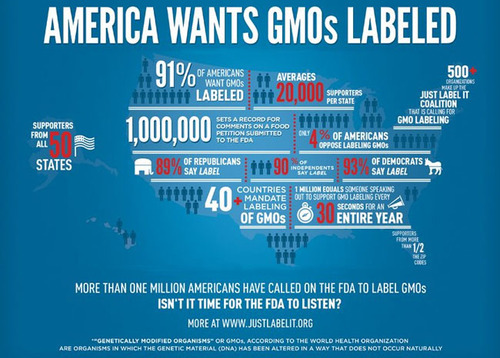Just label it! Seriously, the consumer should be empowered to mediate!
– – – –
Can genetically modified crops grow in harmony with their non-GMO counterparts?
The debate between the pro-biotech and non-GMO camps increasingly looks more like scorched earth than common ground. Biotech seed makers like Monsanto Co. and Syngenta AG, along with farmer groups, argue that genetically modified crops are critical to feed a growing global population. Organic food companies and consumer groups charge that GMO crops promote a chemical-heavy approach to farming that’s harsh on land and animals and could contribute to human-health problems.
Anti-GMO, Biotech Factions Clash at Food Summit – is it for our benefit?
The increasingly polarized debate prompted the U.S. Department of Agriculture to convene Thursday a two-day summit on “agricultural coexistence” that seeks to mend some farmland fence-posts.
“The one thing I am really tired of is division,” said Tom Vilsack, U.S. Secretary of Agriculture, at the event at North Carolina State University in Raleigh, N.C. “This is about finding a path forward.”
But finding that path appeared difficult, with some speakers on both sides of the issue offering few signs of compromise.
“Organic is the future of American agriculture,” said Errol Schweizer, executive global grocery coordinator for Whole Foods Market Inc. Organic crops are grown without GMO seeds.
“We’re not going to feed the world with organic foods,” said Dan Glickman, executive director of the Aspen Institute, a public policy think tank in Washington, and a former U.S. secretary of agriculture.

One thing both factions agree on: The discord costs money. Tens of millions of dollars have been spent advocating for and against state ballot initiatives and legislation requiring labels for foods made with GMOs.
Meanwhile, organic farmers spend thousands of dollars creating buffer zones in their fields to guard against the spread of neighbors’ GMO crop pollen and related pesticides, and setting up systems to ensure harvested grain doesn’t mix with GMO varieties, said Laura Batcha, chief executive of the Organic Trade Association, speaking at the event.
Biotech-crop advocates worry the debate over labeling and continued questions over the crops’ safety is slowing scientific advancements and new products that could help farmers raise hardier crops and produce more food, Mr. Glickman said. The Food and Drug Administration and many U.S. health and science groups say food made with the ingredients is safe.
Some farmers at the event said they took the intensified scrutiny of biotech crops personally.
“For retailers to talk about one production system over another as being the gold standard disparages the production system I use, and I don’t think that’s conducive to having a conversation about coexistence,” said Ron Moore, who grows soybeans, corn and alfalfa near Roseville, Ill., and serves as secretary of the American Soybean Association.
Farmers of all sorts need to acknowledge that “a significant percentage of our community wants to know whether or not they’re eating GMOs,” said Lynn Clarkson, president of Clarkson Grain Co., a Cerro Gordo, Ill., company that specializes in marketing non-biotech crops.
Mr. Clarkson suggested labeling all foods that do not contain genetically engineered ingredients under a federal standard, though others in the non-GMO camp continued to argue for a federal rule requiring labels for food containing GMOs.
Some non-GMO farmers and food makers already feel they bear a greater economic burden than their biotech-using counterparts, however. Some farmers adjust their planting to help ensure non-GMO crop fields remain free of biotech plants, Ms. Batcha said, and Whole Foods’ Mr. Schweizer said his company had struggled to find enough crops to make organic products for its shelves.
“I actually am importing heirloom corn from Mexico,” Mr. Schweizer said. “It’s a huge issue.”
One place USDA officials sought common ground Thursday: the lunch menu. Attendees could choose from GMO-derived selections – grilled chicken breast, corn salsa and roasted sugar beets – as well as an organic menu including free-range chicken, wild rice pilaf and salad. The competing menu choices were served at separate tables.

